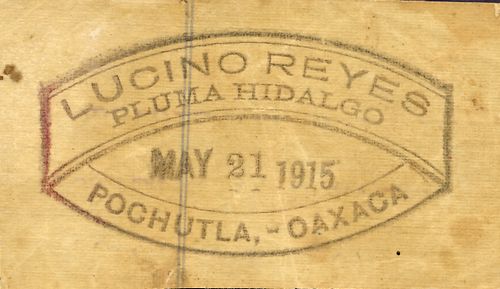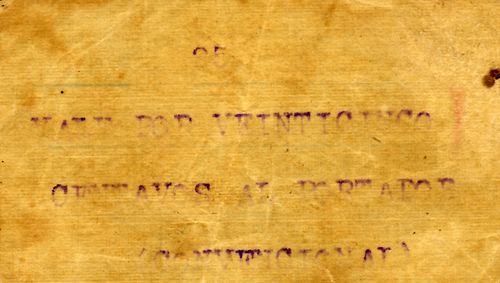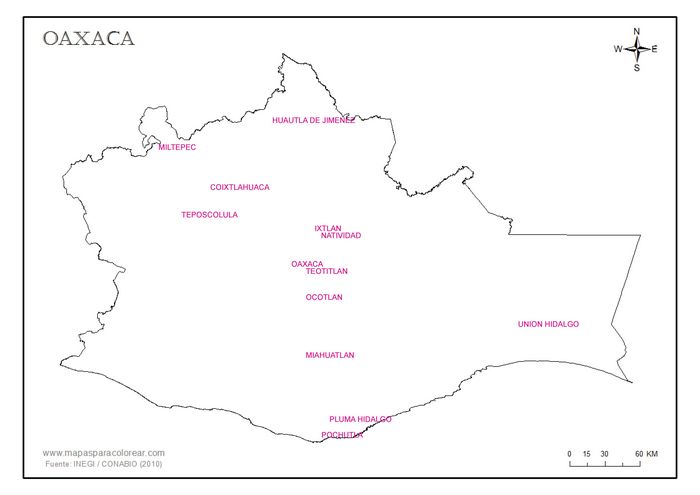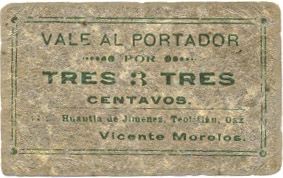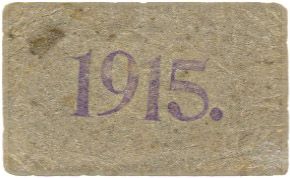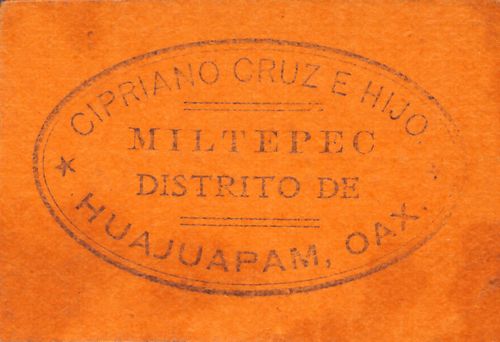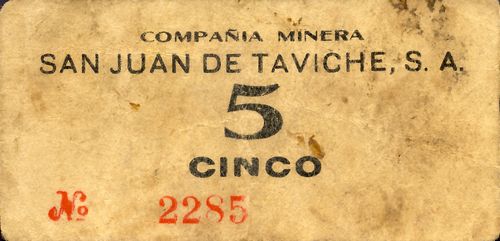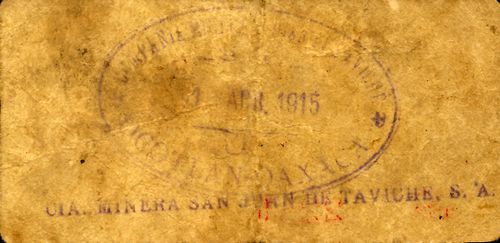Private issues
During the Revolution various private concerns issued low-value vales to make up for the shortage of small change and to ease purchases. The known vales that carry a date are dated April, May or June 1915.
On 23 August 1915 the Secretario General, Arturo Osorio, issued circular núm. 19 to the jefes politicosAO, Fondo Histórico, sección Período revolucionario, serie Gobernación, caja 112, exp. 5. It noted that some commercial and industrial houses had issued bonos without the corresponding authorization. Though these bonos had proved useful the government needed to ensure the guarantees necessary for their issue, circulation and redemption. So Osorio required of each jefe politico, within ten days, a detailed report of the commercial or industrial houses and individuals that had issued bonos or vales, with details of the number and value issued. The total value of the issue should be deposited in the Oficina de Contribuciones and anyone not making such a deposit, or continuing to issue bonos or vales without the corresponding and prior authorization of the Government, would be punished. In his informe of 16 September governor Dávila said that circular núm. 19 had be directed to all the merchants, farmers, industrialists or simple individuals (todos los comerciantes, agricultores, industriales o simples particulares) who had issued bonos or valesAO, Fondo Gobierno, sección Secretaría del Despacho, serie Informes, caja 4825, exp.4.
On 9 October, in his circular núm. 25ibid., Osorio had to note that the majority of jefes politicos had not yet sent the detailed reports that he asked for or acknowledged receipt of any deposits. He repeated his request and stressed the urgency.
It would be useful if we could locate any of the reports that jefes politicos managed to make.
Huautla de Jiménez
Vicente Morelos
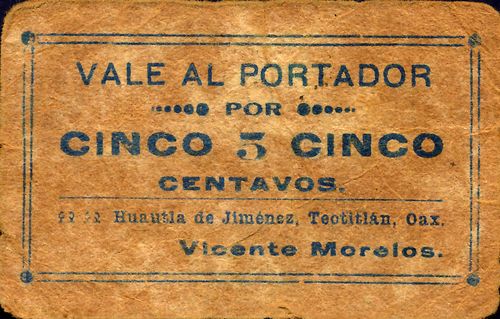
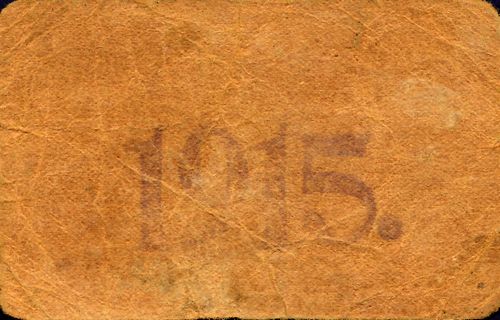
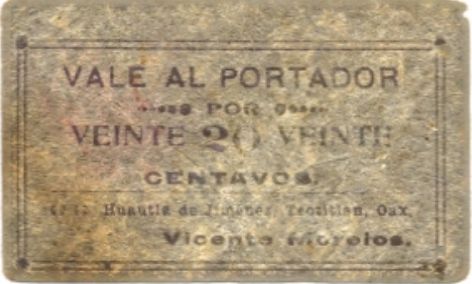
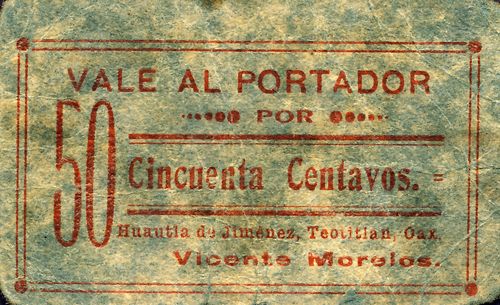
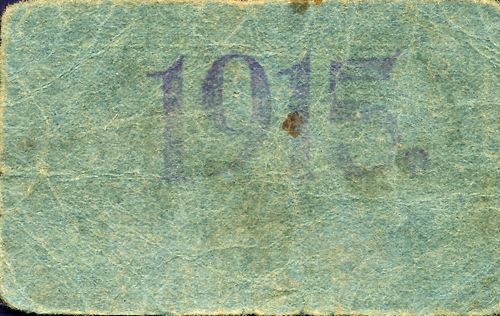
Vicente Morelos was a leading citizen of Huautla who served as Presidente Municipal on three occasions, in 1903, 1911 and 1915. He issued a series of six values (1c, 5c, 10c, 20c, 25c and 50c)
Miltepec
Miltepec is in the Distrito de Huajuapam.
Cipriano Cruz e Hijo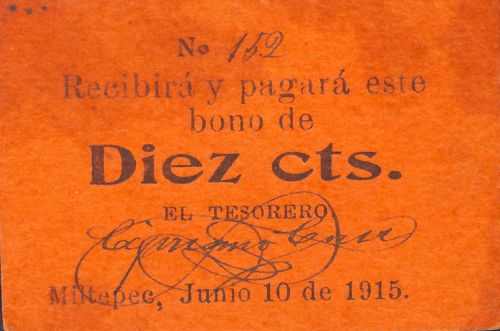
| from | to | total number |
total value |
||
| 10c | includes number 152 |
Since these refer to EL TESORERO these were no doubt a private issue backed up by funds deposited in the Tesorería Municipal. They were signed by or for Cipriano Cruz.
|
Cipriano Cruz was listed as a Preceptor by the Jefatura Política of the district of Huajuápam in 1904Periódico Oficial, Tomo XXIV, Núm. 30, 13 April 1904. He as working for José Larrañaga in 1904Periódico Oficial, Tomo XXIV, Núm. 14, 17 February 1904 and 1906 (by which time Larrañaga had diedPeriódico Oficial, Tomo XXVI, Núm. 12, 10 February 1906. |
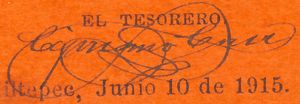 |
Coixtlahuaca
Félix Cruz
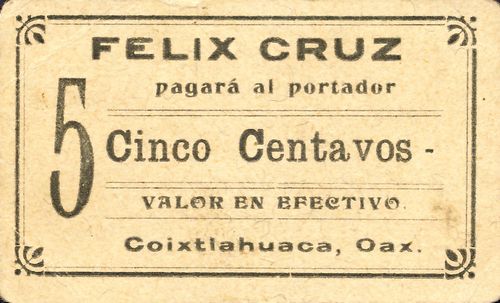
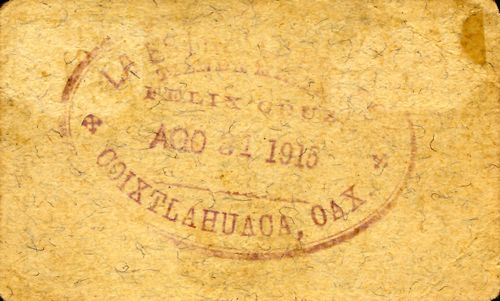
We know of a 5c note dated 31 August 1915 from "La Es[ ]", a grocery store (tienda mixta) run by Félix Cruz. Félix Cruz was the jefe político of Coixtlahuaca in 1905Periódico Oficial, Tomo XXV, Núm. 72, 9 September 19054 and again in 1909Periódico Oficial, Tomo XXIX, Núm. 56, 14 July 1909.
Teposcolula
La Gardenia
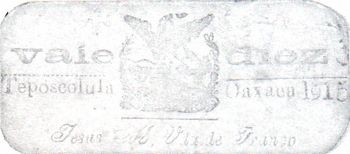
A 10c note issued by Jesús M. Vda. de Franco.
Nochixtlán
Francisco S. Acevedo
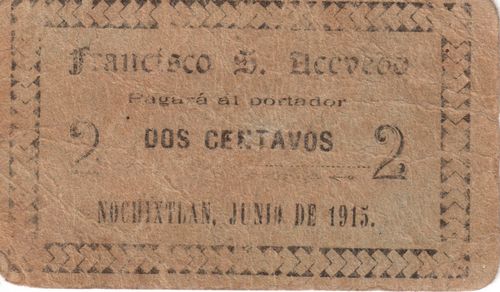
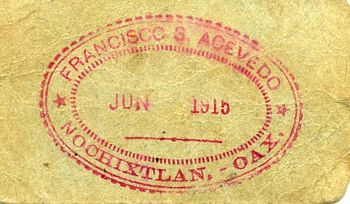
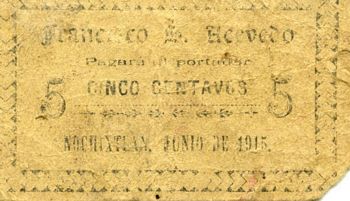
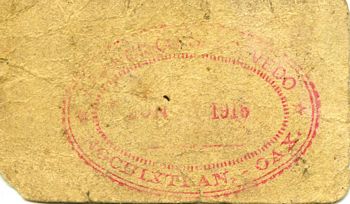
At least two values (2c and 5c), dated to June 1915.
Ixtlan / Natividad
Compañía Minera de Natividad y Anexas
La Natividad mine in the Sierra Juárez was the largest, richest, and longest-running mine in the state, forming part of a matrix of veins that covered an entire mineral zone, traversing three large hills and two deep streams. Discovered and claimed by the Echarri brothers in 1785, it was abandoned in 1828 when the last brother left with the expulsion of the Spanish from Mexico. La Natividad then passed into the hands of the powerful Goytia family, which lost a small fortune trying to drain the water that had invaded it. In 1875 Manuel Dublán (Juárez’s brother in-law) organized a new company to exploit the mine. Capitalized at $250,000, the majority of shares were held by English stockholders, with the remaining shares in the hands of the Oaxacan oligarchy. Constantino Rickards, Juan S. Trápaga, Francisco Quijano, and Demetrio Sodi sat on the board of directors. By 1906 La Natividad was the most productive and technologically advanced mine in the state and employed 450 workers. In that year the Compañía Aviadora, as was, changed its name to the Compañía Minera de Natividad y Anexas, S. A.
In the La Natividad mine, mechanics, carpenters, blacksmiths, and masons, who worked ten-hour days outside the mines, earned between $1 and $3, while the peons received 75 centavos daily. In the interior of the mine, barreteros (drillers) and mine carpenters worked eight and a half hours for $1.25, while the peons worked ten hours for 87 centavos a day. The barreteros also could be paid by piecework, receiving $1.12 for each metre drilled, and $1.25 per metre if they worked fulltimeAO, Gob., Fom., Estadísticas, Tlacolula. 1907 and Report by owner of the hacienda, January 1912.
During the first five years of the Revolution the mine continued to operate with difficulties, mainly because the railways were destroyed by the revolutionaries and this impeded the movement of ore, machinery, tools and other necessary items. Dávila’s declaration of state sovereignty in 1915 intensified the problems, as the serrano forces forced the company to repair armaments and make grenades, and shortly after, it was completely taken over. The population was reduced to a fifth, some joining the revolutionary force and others driven away by the shortage of food.
These vales were signed by [ ][identification needed].
 |
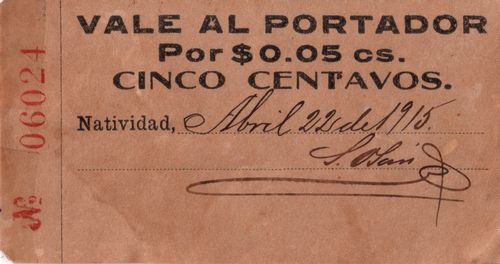
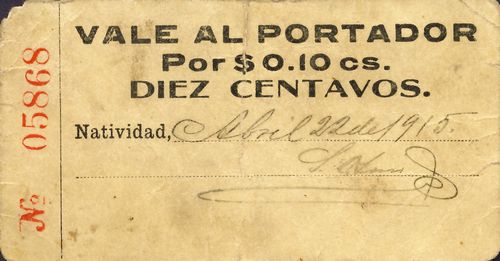
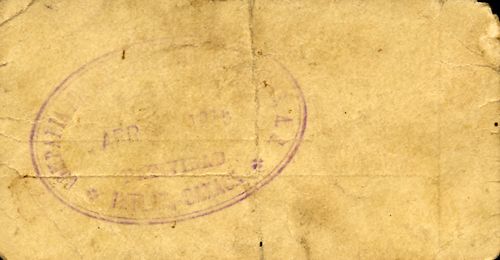
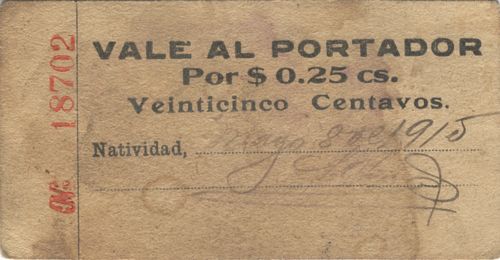
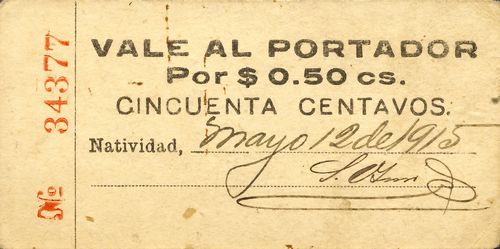
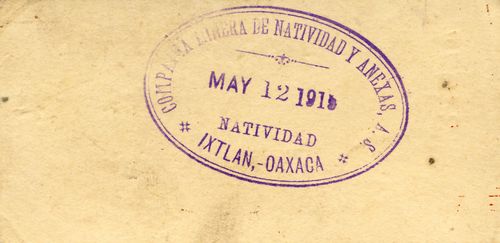
and a different design
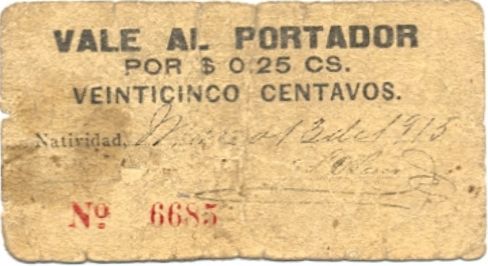
| date on note | from | to | total number |
total value |
||
| 5c | 22 April 1915 | includes number 06024 | ||||
| 10c | 22 April 1915 | includes numbers 05868 and 08008 | ||||
| 25c | 8 May 1915 | includes numbers 18702 to 22278CNBanxico #11813 | ||||
| 12 May 1915 | includes number 25852CNBanxico #5665 | |||||
| 13 May 1915 | different design includes number 6685CNBanxico #5666 |
|||||
| 22 May 1915 | includes number 27874 | |||||
| 50c | 12 May 1915 | includes numbers 29667CNBanxico #11814 to 34377 |
Oaxaca
Casino de Oaxaca
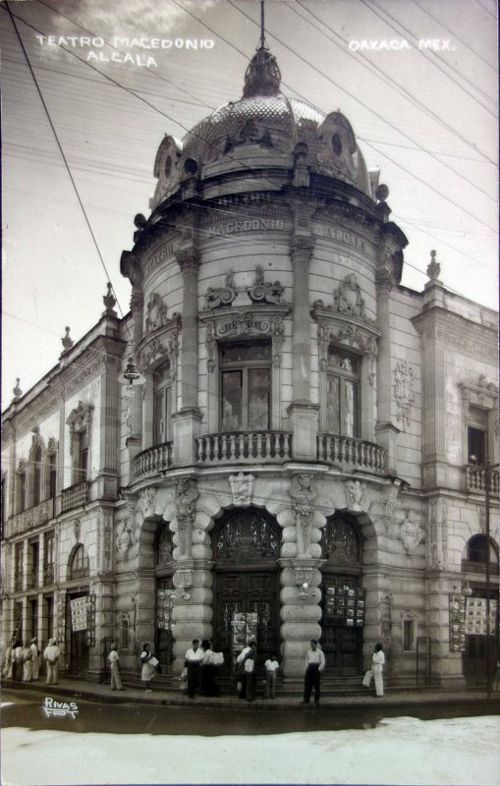
The Teatro Casino (originally called Luis Mier y Terán and now Macedonio Alcalá) is located on the corner of avenida Independencia and 5 de Mayo. Its construction was started in 1904 and completed in 1909, with its inauguration on 5 September. It is built in an art noveau style, with on its facades the lettering ‘Casino de Oaxaca’.
It issued at least four values (5c[image needed], 10c[image needed], 20c[image needed] and 30c, all identical except for the denomination and in different colours.

| from | to | total number |
total value |
||
| 5c | |||||
| 10c | |||||
| 20c | |||||
| 30c | includes number 467 |
La Universal y La Concordia

| from | to | total number |
total value |
||
| 5c | |||||
| 10c | includes number 622 | ||||
| 20c |
At least three values (5c[image needed], 10c, and 20c[image needed]), all identical except for the denomination and in different colours. The H. Franco of "H. Franco y Hermano" could have been Herminio Franco who signed the Cámara de Comercio notes.
Angel San German
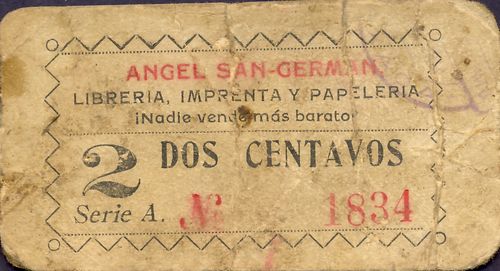
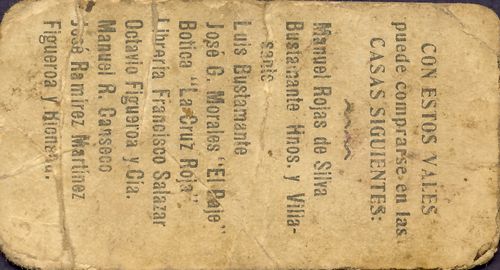
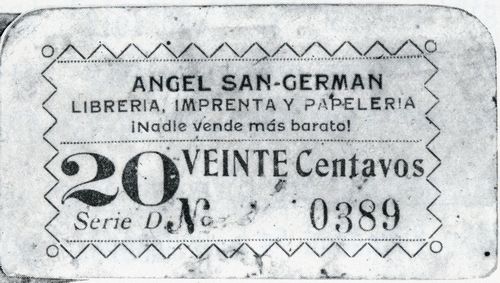
| series | from | to | total number |
total value |
||
| 2c | A | includes numbers 1834 to 1892 | ||||
| 5c | B | |||||
| 10c | C | includes number 0182 | ||||
| 20c | D | includes number 0389 |
A set of at least four different values that could be used in the following stores: Manuel Rojas de Silva; Bustamante Hnos. y Villasante; Luis Bustamante; José G. Morales "El Peje"; Botica "La Cruz Roja"; Librería Francisco Salazar; Octavio Figueroa y Cía.; Manuel R. Canseco; José Ramirez Martínez, and Figueroa y Richard.
These carry the title of Angel San-German who no doubt printed the notes and might have also accepted them. Alternatively he could have used the notes for a piece of advertising: Nobody is cheaper (¡Nadie vende más barato!).
Teotitlán del Camino
Cafetal “Maria Luisa”
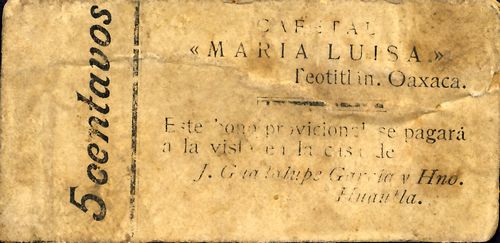
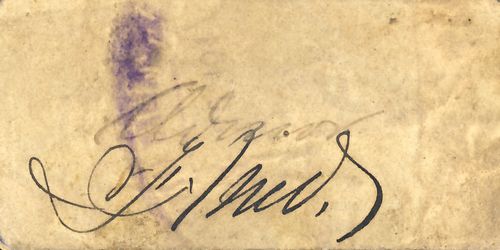
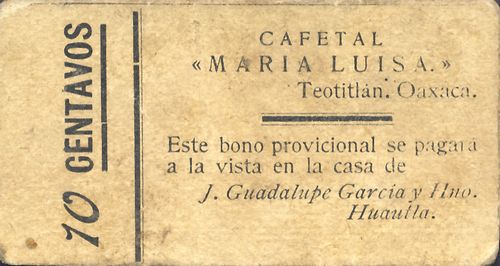
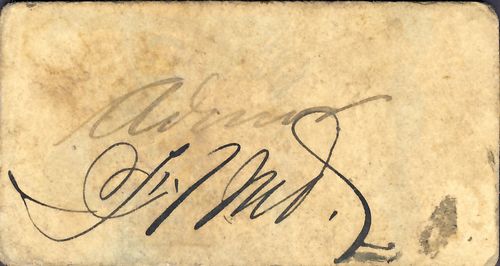
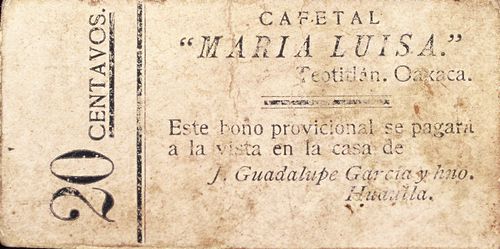
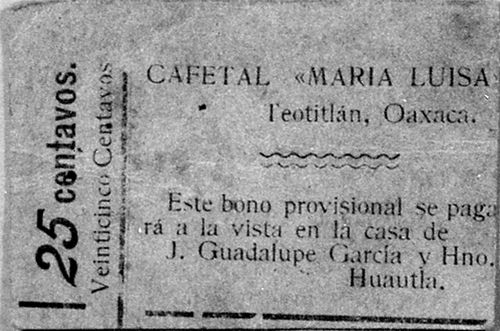
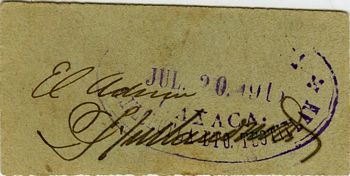
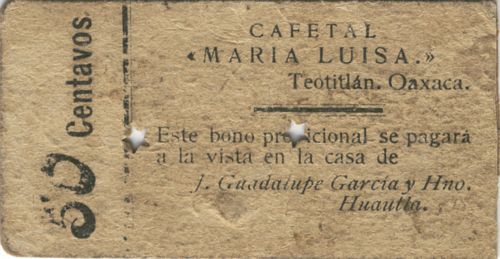
This coffee plantation is located in Santa María Chilchotla, in the Teotitlan district. In 1912 it was of 4,262 hectares and owned by Agustín MacClean.
These notes were redeemable on presentation at J. Guadalupe García y Hno. in Huautla, a town 18 kilometres away.
The 10c note has a handstamped date of 25 July 1915 and the 25c note 20 July 1915 on the reverse.
“La Teotiteca” y “La Aurora”
In 1912 the Cafetal Netzahualcóytl of 3,500 hectares was owned by M. Gamboa Moreno y Hnos.
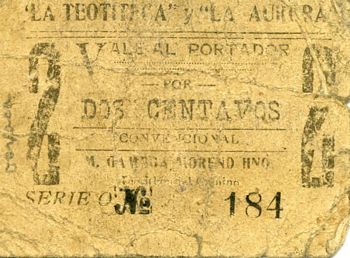
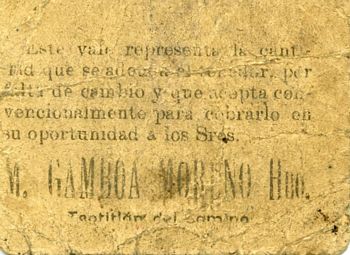
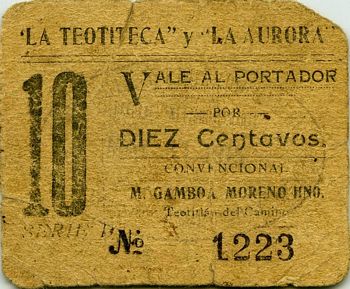
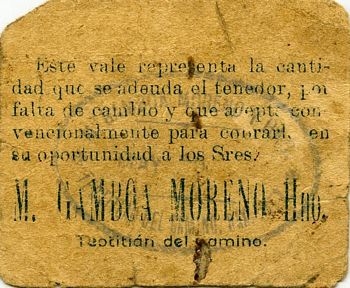
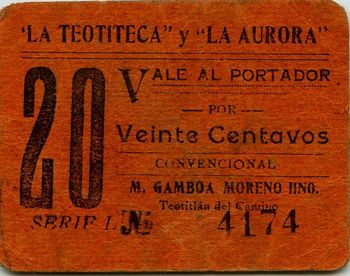
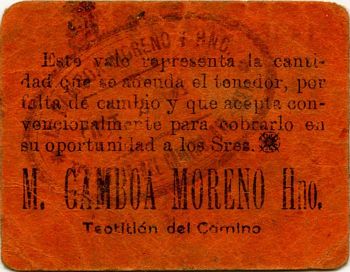
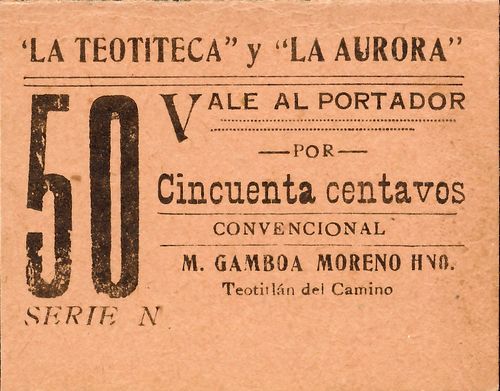
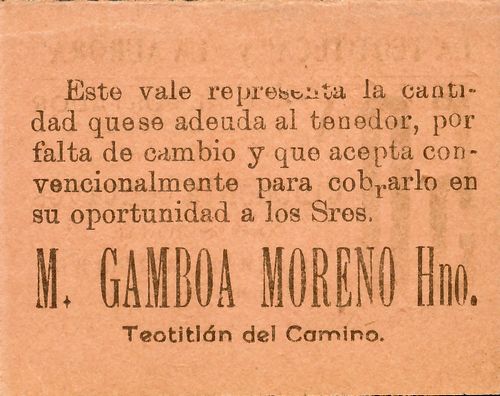
| series | from | to | total number |
total value |
||
| 1c | ||||||
| 2c | O | includes number 184 | ||||
| 10c | D | includes number 1223 | ||||
| 20c | L | includes number 4174 | ||||
| 25c | ||||||
| 50c | N |
A series of at least six values (1c[image needed], 2c, 10c[image needed], 20c[image needed], 25c[image needed] and 50c). All these notes are similar except for the denomination. On the reverse it acknowleges that they were a response to a shortage of small change and would be redeemed in time by M. Gamboa Moreno (Este vale representa la cantidad quese adeuda al tenedor, por falta de cambio y que acepta convencionalmente para cobrarlo en su oportunidad).
Ocotlán
Compañía Minera San Juan de Taviche, S. A.
This mine was located at San Jerónimo Taviche, 18 kilometres south east of Ocotlán.
| from | to | total number |
total value |
||
| 5 | includes number 2285 |
Miahuatlán
R. Albores
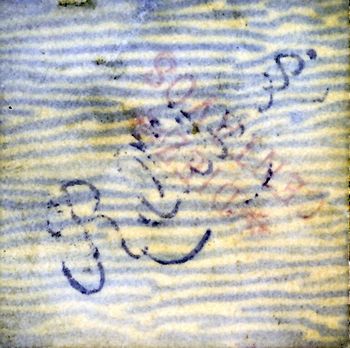
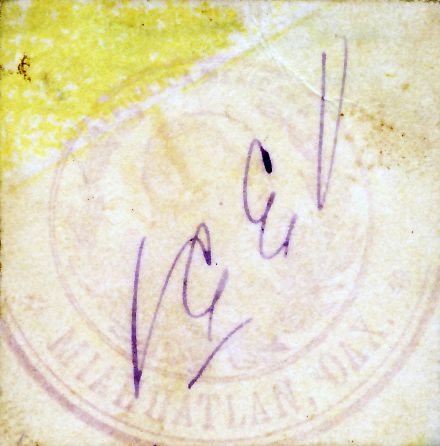
This concern issued a series of at least four values (5c, 10c, 20c and 25c).
Nabor Alderete
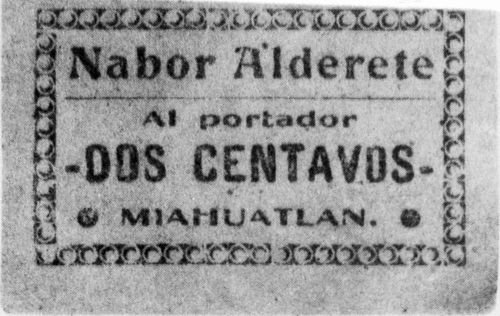
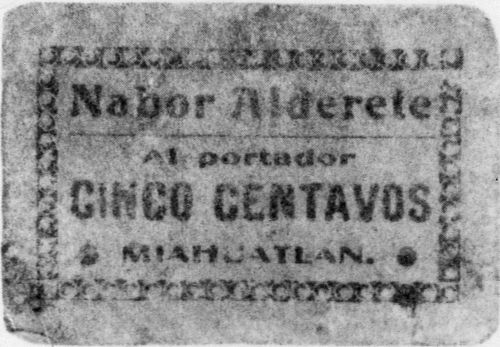
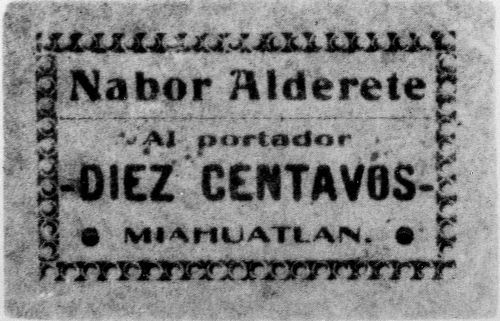
Nabor Alderete was owner of the coffee plantation “El Gólgota” in Pluma HidalgoPeriódico Oficial, tomo XXVIII, núm. 37, 6 May 1908. In 1912 he was a Juez de primera instancia in MiahuatlánPeriódico Oficial, tomo XXXII, núm. 17, 29 February 1912.
Pluma Hidalgo
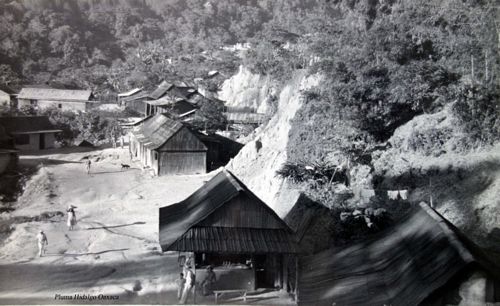
Alfredo Osorio Ortiz
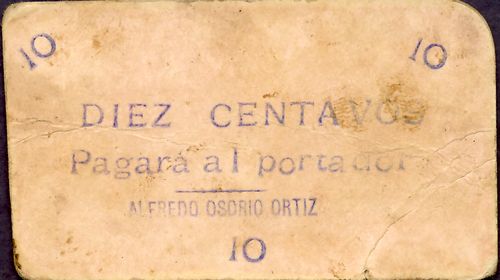
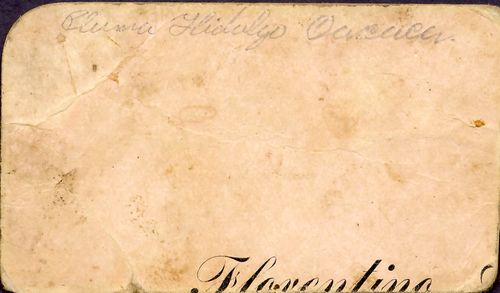
Alberto G. Belderrain
These notes probably came from at least three different series.
Series 1
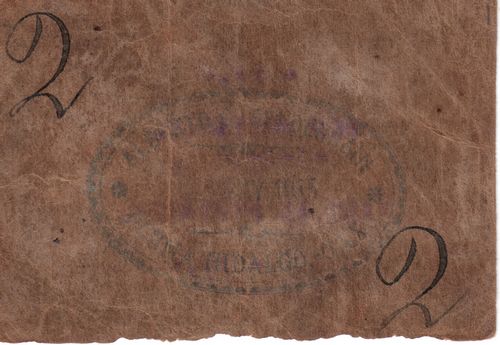
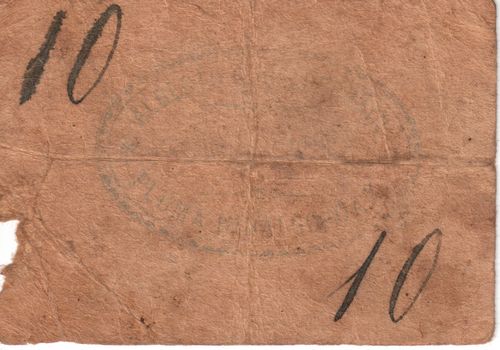
Series 2
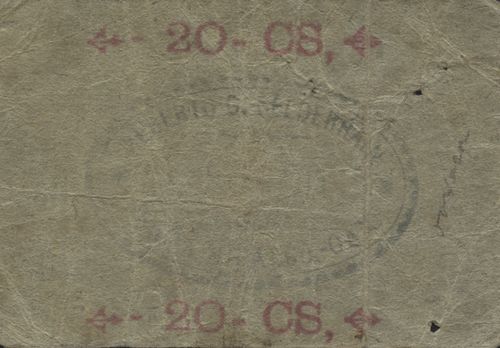
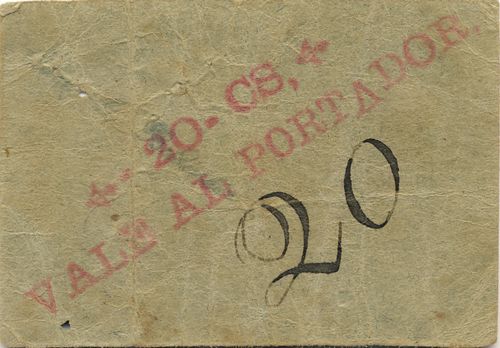
Series 3
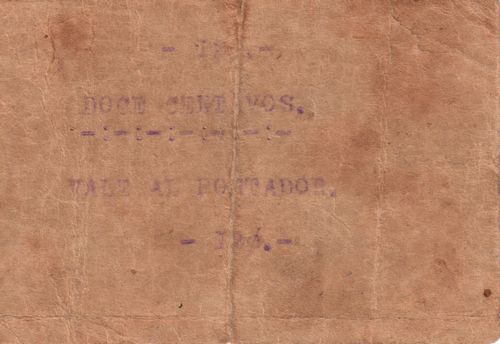
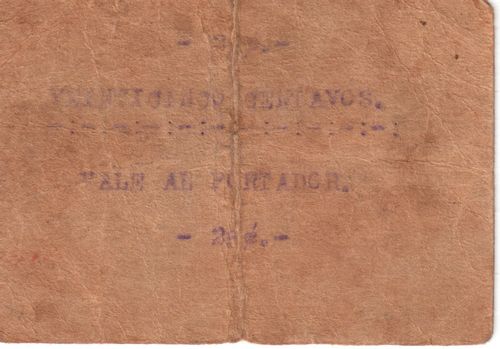
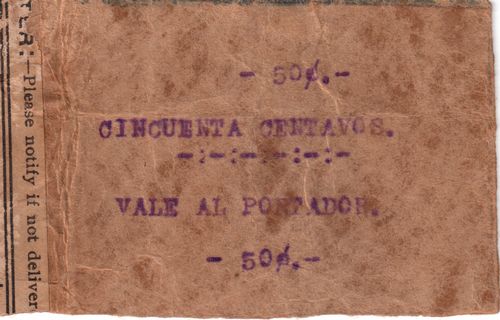
The 2c has a handstamped date of 2[ ] May 1915, the 12c 19 April 1915, the 25c 16 April and 27 April, the 50c 20 May 1915.
An Alberto G. Belderrain was owner of the Concordia coffee plantation, one of the largest in the district, by 1889El Avisador de Puerto Angel, Tomo I. Núm. 2, 1 January 1889 and Núm. 8, 1 April 1889 and had also acquired the Eureka, Nubes and Mercedes plantations by 1896.
Adolfo E. Silva
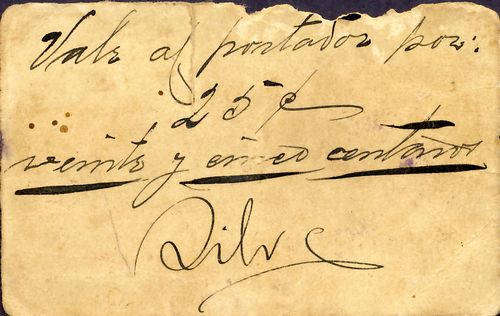
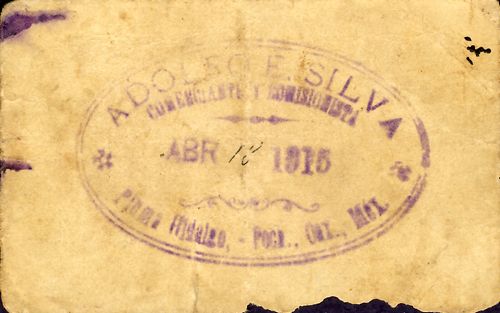
Adolfo E. Silva was a leading coffee grower. When the plantation owners decided to form a “Unión Cafetara de Pluma Hidalgo” in October 1909 Silva was elected the first TreasurerPeriódico Oficial, 10 December 1909; El Imparcial, Tomo XXVII, Núm. 4786, 26 October 1909; El Tiempo, 27 October 1909; The Mexican Herald, 28 October 1909.
Lucino Reyes
